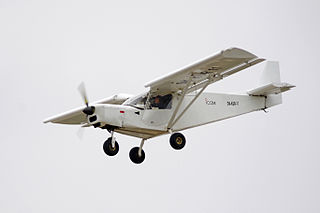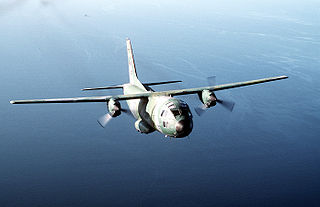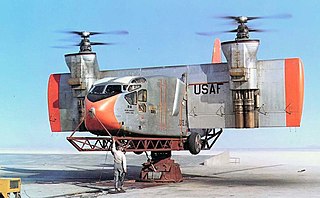
This is a list of aircraft which are classified as having Short Takeoff and Landing, or STOL, characteristics.
Contents
The STOL class excludes vertical takeoff and landing (VTOL) types, rotorcraft, aerostats and most light aircraft.

This is a list of aircraft which are classified as having Short Takeoff and Landing, or STOL, characteristics.
The STOL class excludes vertical takeoff and landing (VTOL) types, rotorcraft, aerostats and most light aircraft.
| Type | Country | Date | Role | Status | Take-off to 50 ft (15 m) | Landing from 50 ft (15 m) | Notes |
|---|---|---|---|---|---|---|---|
| AAC Angel | US | 1984 | Utility | Production | 1,404 ft (428 m) | 1,046 ft (319 m) | [1] |
| Aircraft Industries L 410 NG | Czech Republic | 2015 | Utility | Production | 1,936 ft (590 m) | 1,969 ft (600 m) | [2] |
| Antonov An-14 | Soviet Union | 1958 | Transport | Production | 656 ft (200 m) | 985 ft (300 m) | [3] |
| Antonov An-72 | Soviet Union | 1977 | Transport | Production | 1,312 ft (400 m) | 1,148 ft (350 m) | [4] |
| Auster AOP.9 | UK | 1954 | Artillery observer | Production | 675 ft (206 m) | 150 ft (46 m) | [5] |
| Australian Aircraft Kits Hornet STOL | Australia | 2004 | Ultralight | Production | 656 ft (200 m) | 623 ft (190 m) | [6] |
| Bounsall Super Prospector | US | 1990 | Homebuilt | Production | 300 ft (91 m) | 250 ft (76 m) | [7] |
| Boeing YC-14 | US | 1976 | Transport | Prototype (Cancelled) | [ citation needed ] | ||
| Britten-Norman Defender | UK | 1970 | Transport | Production | 1,050 ft (320 m) | 995 ft (303 m) | [8] |
| Boeing/NASA C-8A AWJSRA | US | 1972 | Jet flap STOL research | Production | Augmented Wing Jet-flap STOL Research Aircraft[ citation needed ] | ||
| Britten-Norman Islander | UK | 1965 | Airliner | Production | 1,100 ft (335 m) | 960 ft (293 m) | [9] |
| CASA C-212 Aviocar | Spain | 1974 | Transport | Production | 2,001 ft (610 m) | 1,516 ft (462 m) | Airliner, cargo and ground attack variants [10] |
| Conroy Stolifter | US | 1968 | Utility | Prototype | 450 ft (137 m) | 400 ft (122 m) | Converted Cessna Skymaster. [11] |
| De Havilland Canada DHC-2 Beaver Mk 1 | Canada | 1947 | Transport | Production | 1,015 ft (309 m) | 1,000 ft (305 m) | [12] |
| De Havilland Canada DHC-2 Beaver Mk III | Canada | 1947 | Transport | Production | 920 ft (280 m) | 870 ft (265 m) | [12] |
| De Havilland Canada DHC-3 Otter | Canada | 1951 | Transport | Production | 1,155 ft (352 m) | 880 ft (268 m) | [13] |
| De Havilland Canada DHC-4 Caribou | Canada | 1959 | Transport | Production | 1,040 ft (317 m) | 590 ft (180 m) | [14] |
| De Havilland Canada DHC-5 Buffalo | Canada | 1965 | Utility | Production | 2,100 ft (640 m) | 2,100 ft (640 m) | [15] |
| De Havilland Canada DHC-6 Twin Otter | Canada | 1966 | Utility | Production | 1,200 ft (366 m) | 1,050 ft (320 m) | [16] |
| De Havilland Canada Dash 7 | Canada | 1975 | Airliner | Production | 1,200 ft (366 m) | 1,050 ft (320 m) | [17] |
| Dornier Do 27 | Germany | 1955 | Utility | Production | 558 ft (170 m) | 525 ft (160 m) | [18] |
| Dornier Do 28 | Germany | 1959 | Utility | Production | 1,020 ft (311 m) | 1,000 ft (305 m) | [16] |
| Dornier Do 228 | Germany | 1981 | Utility | Production | 2,600 ft (792 m) | 1,480 ft (451 m) | [ citation needed ] |
| Dornier Do 29 | Germany | 1958 | Utility | Prototype / research | [ citation needed ] | ||
| Dornier P.360 | Germany | 1967 | Military transport aircraft | Prototype / research | Similar to Armstrong Whitworth AW.681 [19] | ||
| Evangel 4500 | US | 1964 | Transport | Production | 1,125 ft (343 m) | 1,140 ft (347 m) | [20] |
| Fieseler Fi 156 Storch | Germany | 1936 | Utility | Production | 350 ft (107 m) | 310 ft (94 m) | [ citation needed ] |
| Helio Courier H-295 | US | 1955 | Utility | Production | 610 ft (186 m) | 520 ft (158 m) | [21] "Helioplane #1" demonstrator first flew 1949 [22] |
| IAI Arava | Israel | 1972 | Transport | Production | 984 ft (300 m) | 902 ft (275 m) | [23] |
| Javelin V6 STOL | US | 1949 | Homebuilt | Production | 150 ft (46 m) | 300 ft (91 m) | Piper PA-20 Pacer conversion. [7] |
| Just Superstol | US | 2012 | Homebuilt | Production | 550 ft (168 m) | 450 ft (137 m) | [24] |
| Let L-410 Turbolet | Czech Republic | 1969 | Utility | Production | 1,673 ft (510 m) | 1,640 ft (500 m) | [25] |
| Maule M-5 | US | 1974 | Utility | Production | 550 ft (168 m) | 600 ft (183 m) | [26] [27] |
| McDonnell Douglas YC-15 | US | 1975 | Transport | Prototype (Cancelled) | |||
| Murphy Radical | Canada | 2016 | Utility | Production | 400 ft (122 m) | 300 ft (91 m) | [28] [29] |
| NAL Quiet STOL research aircraft ASKA | Japan | 1985 | Research | Prototype | [30] | ||
| NASA Quiet Short-Haul Research Aircraft | US | 1974 | Research | Prototype | |||
| PAC P-750 XSTOL | New Zealand | 2001 | Utility | Production | 1,196 ft (365 m) | 950 ft (290 m) | [31] |
| Peterson 260SE/Wren 460 | US | 1988 | Utility | Production | 1,000 ft (305 m) | 1,000 ft (305 m) | Conversion of Cessna 182. [32] |
| Pilatus PC-6 Porter | Switzerland | 1959 | Utility | Production | 600 ft (183 m) | 550 ft (168 m) | [33] |
| Piper J-3 Cub | US | 1938 | Utility | Production | 755 ft (230 m) | 885 ft (270 m) | [34] |
| PZL-104 Wilga | Poland | 1962 | Utility | Production | 625 ft (191 m) | 780 ft (238 m) | [35] |
| PZL-105M | Poland | 1989 | Utility | Prototype | 1,109 ft (338 m) | 1,070 ft (326 m) | [36] |
| Quest Kodiak | US | 2005 | Transport | Production | 760 ft (232 m) | 915 ft (279 m) | [37] |
| Scottish Aviation Pioneer | UK | 1947 | Transport | Production | 555 ft (169 m) | 660 ft (201 m) | [38] [39] |
| Scottish Aviation Twin Pioneer | UK | 1955 | Transport | Production | 1,071 ft (326 m) | 870 ft (265 m) | [40] |
| ShinMaywa US-2 | Japan | 2007 | Air-Sea Rescue | Production | 920 ft (280 m) | 1,080 ft (329 m) | [41] |
| Short SC.7 Skyvan | UK | 1963 | Transport | Production | 1,050 ft (320 m) | 1,485 ft (453 m) | [42] |
| SIAI-Marchetti FN.333 Riviera | Italy | 1952 | Amphibian | Production | 1,400 ft (427 m) | 1,100 ft (335 m) | [43] |
| SIAI-Marchetti SM.1019 | Italy | 1969 | Utility | Production | 1,185 ft (361 m) | 922 ft (281 m) | [44] |
| Slepcev Storch | Serbia | 1994 | Ultralight | Production | 126 ft (38 m) | 110 ft (34 m) | Scale replica of Fieseler Fi 156 Storch. [45] |
| Spectrum SA-550 | US | 1983 | Transport | Production | 675 ft (206 m) | 675 ft (206 m) | Converted Cessna Skymaster. [46] |
| Sukhoi Su-80 | Russian Federation | 2001 | Transport | Production | 2,686 ft (819 m) | 1,715 ft (523 m) | [47] |
| Westland Lysander I | UK | 1936 | Army cooperation | Production | 690 ft (210 m) | 990 ft (300 m) | [48] [49] |
| Zenith STOL CH 701 | US | 1986 | Trainer | Production | 1,257 ft (383 m) | 1,257 ft (383 m) | [50] [ citation needed ] |
| Zenith STOL CH 801 | US | 2011 | Homebuilt | Production | 400 ft (122 m) | 300 ft (91 m) | [51] [ citation needed ] |
The take-off run, fully loaded, is ... 180 yd to clear a 50ft obstacle
With full load...clear a 50ft obstacle in 230 yards
approach distance over a 50ft. obstacle to rest 330 yards

The Hawker Siddeley Harrier is a designed and produced by the British aerospace company Hawker Siddeley. It was the first operational ground attack and reconnaissance aircraft with vertical/short takeoff and landing (V/STOL) capabilities and the only truly successful V/STOL design of that era.
A vertical take-off and landing (VTOL) aircraft is one that can take off and land vertically without relying on a runway. This classification can include a variety of types of aircraft including helicopters as well as thrust-vectoring fixed-wing aircraft and other hybrid aircraft with powered rotors such as cyclogyros/cyclocopters and gyrodynes.
For fixed-wing aircraft, ground effect is the reduced aerodynamic drag that an aircraft's wings generate when they are close to a fixed surface. Reduced drag when in ground effect during takeoff can cause the aircraft to "float" while below the recommended climb speed. The pilot can then fly just above the runway while the aircraft accelerates in ground effect until a safe climb speed is reached.

Takeoff is the phase of flight in which an aerospace vehicle leaves the ground and becomes airborne. For aircraft traveling vertically, this is known as liftoff.

A short takeoff and landing (STOL) aircraft is a conventional fixed-wing aircraft that has short runway requirements for takeoff and landing. Many STOL-designed aircraft also feature various arrangements for use on airstrips with harsh conditions. STOL aircraft, including those used in scheduled passenger airline operations, have also been operated from STOLport airfields which feature short runways.

The Harrier, informally referred to as the Harrier jump jet, is a family of jet-powered attack aircraft capable of vertical/short takeoff and landing operations (V/STOL). Named after a bird of prey, it was originally developed by British manufacturer Hawker Siddeley in the 1960s. The Harrier emerged as the only truly successful V/STOL design of the many attempted during that era. It was conceived to operate from improvised bases, such as car parks or forest clearings, without requiring large and vulnerable air bases. Later, the design was adapted for use from aircraft carriers.
Aeritalia was an aerospace engineering corporation based in Italy. It was formed out of the merger of two aviation companies, Fiat Aviazione and Aerfer, in 1969.

A tail-sitter, or tailsitter, is a type of VTOL aircraft that takes off and lands on its tail, then tilts horizontally for forward flight.

The Aeritalia G.222 is a medium-sized STOL military transport aircraft. It was developed to meet a NATO specification, but Italy was initially the only NATO member to adopt the type. The United States purchased a small number of G.222s, designating them the C-27A Spartan.

The Bell X-14 is an experimental VTOL aircraft flown in the United States in the 1950s. The main objective of the project was to demonstrate vectored thrust horizontal and vertical takeoff, hover, transition to forward flight, and vertical landing.

The Bell X-22 is an American V/STOL X-plane with four tilting ducted fans. Takeoff was to selectively occur either with the propellers tilted vertically upwards, or on a short runway with the nacelles tilted forward at approximately 45°. Additionally, the X-22 was to provide more insight into the tactical application of vertical takeoff troop transporters such as the preceding Hiller X-18 and the X-22's successor, the Bell XV-15. Another program requirement was a true airspeed in level flight of at least 525 km/h.

The Convair XFY-1 Pogo was an experimental VTOL aircraft developed during the early years of the Cold War. It was intended to be a high-performance fighter aircraft capable of operating from small warships. Lockheed and Convair were awarded contracts to build experimental VTOL fighters, with Convair producing the XFY-1, also known as the "Pogo."

The Hiller X-18 was an experimental cargo transport aircraft designed to be the first testbed for tiltwing and V/STOL technology.

The de Havilland Canada DHC-5 Buffalo is a short takeoff and landing (STOL) utility transport turboprop aircraft developed from the earlier piston-powered DHC-4 Caribou. The aircraft has extraordinary STOL performance and is able to take off in distances much shorter than even most light aircraft can manage.

The Ryan XV-5 Vertifan was a jet-powered V/STOL experimental aircraft in the 1960s. The United States Army commissioned the Ryan VZ-11-RY in 1961, along with the Lockheed VZ-10 Hummingbird. It successfully proved the concept of ducted lift fans, but the project was cancelled after multiple fatal crashes unrelated to the lift system.

The Dassault Mirage IIIV, also spelled Mirage III V, was a French vertical take-off and landing (VTOL) prototype fighter aircraft of the mid-1960s developed and produced by Dassault Aviation.

The Rockwell XFV-12 was a prototype supersonic United States Navy fighter which was built in 1977. The XFV-12 design attempted to combine the Mach 2 speed and AIM-7 Sparrow armament of the McDonnell Douglas F-4 Phantom II in a VTOL fighter for the small Sea Control Ship which was under study at the time. On paper, it looked superior to the subsonic Hawker Siddeley Harrier attack fighter. However it was unable to demonstrate an untethered vertical takeoff and its inability to meet performance requirements terminated the program.

The Ling-Temco-Vought (LTV) XC-142 is a tri-service tiltwing experimental aircraft designed to investigate the operational suitability of vertical/short takeoff and landing (V/STOL) transports. An XC-142A first flew conventionally on 29 September 1964, and on 11 January 1965, it completed its first transitional flight by taking off vertically, changing to forward flight, and finally landing vertically. Its service sponsors pulled out of the program one by one, and it eventually ended due to a lack of interest after demonstrating its capabilities successfully.
Aircraft can have different ways to take off and land. Conventional airplanes accelerate along the ground until sufficient lift is generated for takeoff, and reverse the process to land. Some airplanes can take off at low speed, this being a short takeoff. Some aircraft such as helicopters and Harrier jump jets can take off and land vertically. Rockets also usually take off vertically, but some designs can land horizontally.